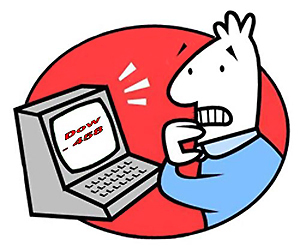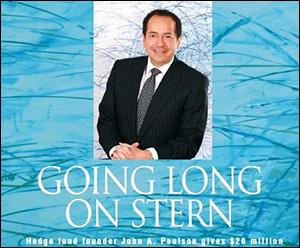By Pam Martens and Russ Martens: October 16, 2014
 If you happened to be sitting behind a trading screen on Wall Street in late August and September 1998, you’ve likely been having some déjà vu over the past seven trading sessions. Intraday rallies continue to fail; there is a thundering stampede into Treasuries; rumors are buzzing about hedge funds in trouble; waves of selling pressure suggest wholesale dumping to meet margin calls.
If you happened to be sitting behind a trading screen on Wall Street in late August and September 1998, you’ve likely been having some déjà vu over the past seven trading sessions. Intraday rallies continue to fail; there is a thundering stampede into Treasuries; rumors are buzzing about hedge funds in trouble; waves of selling pressure suggest wholesale dumping to meet margin calls.
If you needed any more evidence that there is some serious stuff going on behind the scenes on Wall Street, you got it in yesterday’s stock market open. Within minutes the Dow Jones Industrial Average had plunged 370 points in a panic selling spree as buyers went on strike. The Dow was down as much as 458 points in early afternoon before trimming its loses before the final bell to close at a minus 173 points.
It’s all so reminiscent of late August and September 1998 when the five year old hedge fund Long-Term Capital Management L.P., replete with two Nobel laureates on board feeding exotic mathematical formulas into computers, had levered up to the eyeballs in reversion-to-the-mean bets using massive amounts of money borrowed from the major firms on Wall Street. The reversion-to-the-mean thesis was based on the idea that the widened yield spread between risky securities and safer ones would narrow, i.e., revert to the mean.
This was all in the thick of the currency and debt crisis in Russia which dictated, through plain ole common sense, that as that crisis worsened spreads would widen further, not shrink. Which is exactly what they did, causing Long-Term Capital to become Short-Term Capital. The New York Fed had to sit the Wall Street big boys down in its conference room and get agreement on a multi-bank bailout of the teetering hedge fund.
Flash forward to today. U.S. hedge funds have invested billions of dollars in the stock of Dublin-based drugmaker Shire on speculation that U.S. drugmaker, AbbVie, would consummate its buyout of the company, delivering hefty profits to the hedge funds. But the trades have gone seriously awry with Shire losing 29 percent of its value over the past two days on speculation the deal is in trouble.
Early this morning, Reuters has confirmed the hedge funds’ worst nightmare with news that AbbVie “has pulled the plug on its plan to buy Dublin-based Shire, recommending shareholders vote against the proposed $55 billion takeover…”
On top of this harbinger of margin calls are concerns that some hedge funds have made wrong-way bets on the direction of interest rates – putting leveraged money on speculations that rates would rise while now watching them plumb historic record lows around the globe amid rising concerns that we are seeing slowing growth and deflationary forces at work.
There are further reports that hedge funds have suffered additional losses from bets on Fannie Mae and Freddie Mac securities which were delivered a blow in late September when a Federal judge dismissed a lawsuit that would have required the U.S. government, which had to take over the failed firms during the 2008 financial crisis, to share the companies’ profits with shareholders.
Hedge funds are also known to make large, leveraged bets in the oil futures markets and Saudi Arabia’s gambit to effectively launch an oil price war, driving down crude oil prices to four year lows, has caught many oil speculators flat-footed.
Yesterday, Hall Commodities LLP, a hedge fund which manages approximately $100 million in oils and metals, was reported to be shuttering its doors due to poor performance. The largest hedge funds, by comparison, manage billions of dollars, not millions.
Yesterday, Nathan Vardi of Forbes reported that John Paulson’s hedge funds are the second-biggest shareholders of Shire stock, whose price decline “comes at a particularly bad time for Paulson. His main hedge funds performed poorly in September and are down for the year. For example, Paulson’s Advantage Plus Fund fell by about 11% in September and is now down 14% this year. His Advantage Fund was down 13% in the first nine months of the year and his Recovery Fund had lost 6% for the year.” Typically, such performance data is quite stale by the time it gets into the public’s hands.

John Paulson, Hedge Fund Manager, Is Praised in the 2010 Spring/Summer Issue of the Alumni Magazine of the Stern School of Business at NYU
Paulson is that infamous character who helped Goldman Sachs construct the 2007 ABACUS deal, designed to fail so he could make $1 billion betting that it would fail while Goldman Sachs sold it to its clients as a good investment. On April 16, 2010, the SEC had this to say in assessing Paulson’s business morals: “The SEC alleges that one of the world’s largest hedge funds, Paulson & Co., paid Goldman Sachs to structure a transaction in which Paulson & Co. could take short positions against mortgage securities chosen by Paulson & Co. based on a belief that the securities would experience credit events.”
According to the SEC’s complaint, by October 2007, 83 percent of the bonds in the portfolio had been downgraded and 17 percent were on negative watch. By Jan. 29, 2008, 99 percent of the portfolio had been downgraded. The SEC estimated that investors lost more than $1 billion in the deal.
Goldman got off the hook by paying $550 million to settle the charges in 2010. Fabrice Tourre, the young Goldman investment banker and scapegoat involved in the deal, was tried in a civil court case by the SEC and found liable in March of this year for defrauding investors. Tourre paid $825,000 in fines.
Paulson was never charged. Around the time of the allegations, Paulson donated $20 million to NYU and got his name enshrined on the auditorium of its business school – delivering the sickening message to the next generation of business leaders that it’s legal if you can get away with it.

